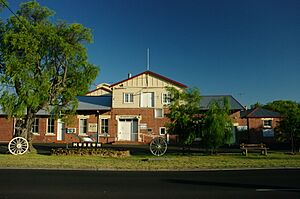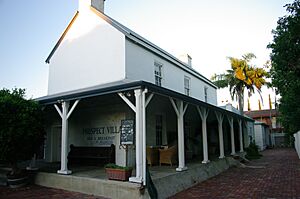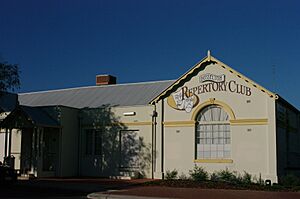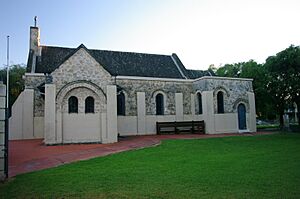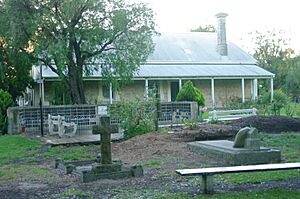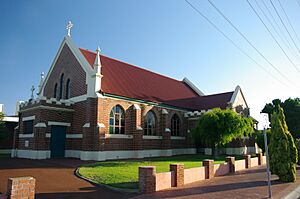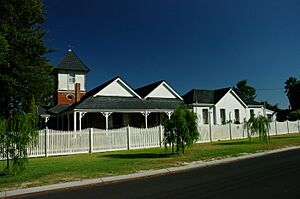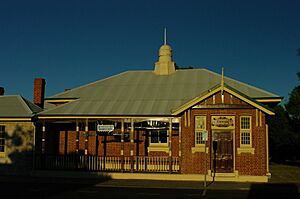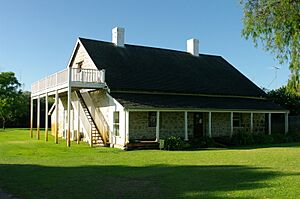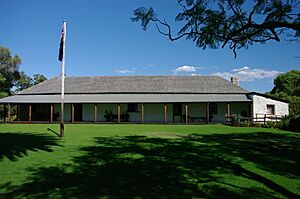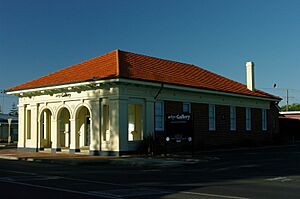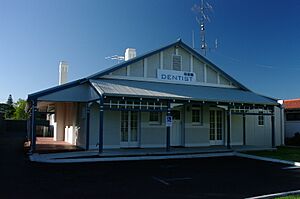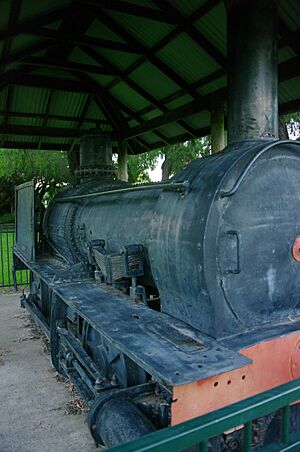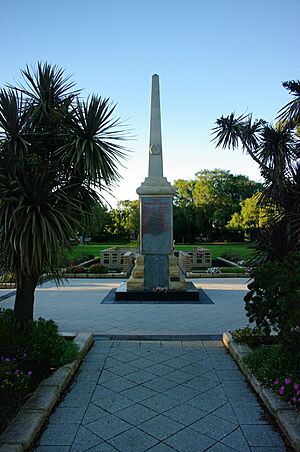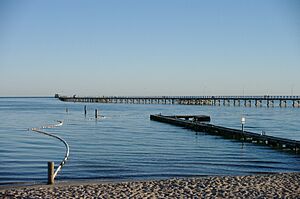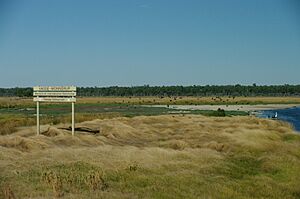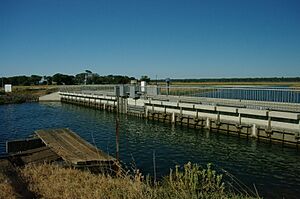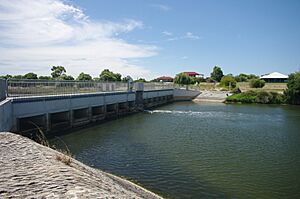List of heritage places in Busselton facts for kids
The List of heritage places in Busselton tells us about special buildings and natural areas in the City of Busselton. These places are important because they show us the history and culture of the area. They are officially recognized by the Western Australian Government's State Heritage Office.
Contents
- Exploring Busselton's Historic Buildings
- Old Butter Factory: A Taste of History
- Prospect Villa: Busselton's Oldest Home
- Weld Hall Theatre: A Stage for the Community
- St Mary's Anglican Church: A Place of Worship and History
- St Joseph's Roman Catholic Church Precinct: Built in Tough Times
- Villa Carlotta: From Convent to Hotel
- Busselton Court House and Police Complex: Law and Order
- Bovell's Cottage: An Early Settler's Home
- Wonnerup Precinct: A Historic Homestead
- Office of the Department of Agriculture: Farming History
- Lady Campion Hostel: A Bush Hospital
- Ballarat Engine: Western Australia's First Steam Train
- Busselton War Memorial: Remembering Heroes
- Busselton's Natural Heritage
- Images for kids
Exploring Busselton's Historic Buildings
Busselton has many old buildings that tell stories about the past. These places have been kept safe so people can learn from them for many years to come.
Old Butter Factory: A Taste of History
The Old Butter Factory was built in 1918. It used to be a place where butter was made! Today, it's a museum where you can learn about Busselton's past. It's also home to the Busselton Historical Society.
Prospect Villa: Busselton's Oldest Home
Prospect Villa was built in 1855 by James Chapman. It is the oldest house still standing in Busselton. Imagine living in a house built almost 170 years ago!
Weld Hall Theatre: A Stage for the Community
The Weld Hall Theatre was built in 1874. Over the years, it has been used for many things. It was once a Mechanics Institute, which was a place for people to learn and read. It also served the RSL and is now a repertory theatre. This means it's a place where plays are performed regularly.
St Mary's Anglican Church: A Place of Worship and History
St Mary's Anglican Church and Graveyard is a very old place of worship. It was built in stages, starting in 1845. The church has a special harmonium and a bell tower. The graveyard is also important because John Bussell, who the area is named after, is buried there.
St Mary's Anglican Church Rectory
The rectory, or priest's house, for St Mary's Anglican Church was built in 1895. It's another old building that shows how the church community grew over time.
St Joseph's Roman Catholic Church Precinct: Built in Tough Times
The current St Joseph's Roman Catholic Church was built in 1933. This was during a very difficult time called the Great Depression. It replaced an older church from 1866. The church was later renovated in 1971.
Villa Carlotta: From Convent to Hotel
Villa Carlotta was built between 1896 and 1904. For many years, it was a convent, a place where nuns lived. In 1952, it was sold and has been used as hotel accommodation ever since.
Busselton Court House and Police Complex: Law and Order
The Busselton Court House and Police Complex dates back to between 1860 and 1900. This is where legal matters were handled and police worked. Today, it's part of the ArtGeo Cultural Complex, a place for arts and culture.
Bovell's Cottage: An Early Settler's Home
Bovell's Cottage was built in 1882. It was owned by Joseph Bovell, who was one of the early settlers in the Busselton area. This cottage gives us a glimpse into the lives of the first people who made Busselton their home.
Wonnerup Precinct: A Historic Homestead
The Wonnerup Precinct includes Wonnerup House, Wonnerup School, and a Teachers cottage. These buildings were constructed between 1837 and 1875. It's a collection of buildings that show what life was like on a large property in early Western Australia.
Office of the Department of Agriculture: Farming History
The Office of the Department of Agriculture was built in 1831. It was also known as the Agricultural Bank of Western Australia. This building played an important role in supporting farming and agriculture in the region.
Lady Campion Hostel: A Bush Hospital
The Lady Campion Hostel was built in 1926. It started as a bush hospital, providing medical care in a rural area, until 1947. After that, it became a private home.
Ballarat Engine: Western Australia's First Steam Train
The Ballarat Engine is a very special piece of history. Built in 1871, it was the first steam locomotive to operate in Western Australia! You can find it at Victoria Square.
Busselton War Memorial: Remembering Heroes
The Busselton War Memorial was built between 1919 and 1920. It was crafted by a famous artist named Pietro Porcelli. This memorial helps us remember and honor those who served in wars.
Busselton's Natural Heritage
Busselton is not just about old buildings; it also has important natural places that are protected.
Busselton Jetty: A Long Walk Through History
The Busselton Jetty is one of Busselton's most famous landmarks. It was built between 1865 and 1911 and is an amazing 1841 metres long! It has faced challenges, including damage from Cyclone Alby. It's a great place to walk and enjoy the ocean.
Broadwater Wetlands: A Home for Wildlife
The Broadwater Wetlands are freshwater wetlands. They are a very important nesting site for many birds and other animals. These wetlands are protected by the EPA to keep them safe for wildlife.
Vasse-Wonnerup Wetlands: A Globally Important Site
The Vasse-Wonnerup Wetlands were recognized in 1990 as a Ramsar site. This means they are wetlands of international importance, especially for waterbirds. It's a special place that helps protect nature on a global scale.
Wonnerup Floodgates: Managing Water Flow
The Wonnerup Floodgates were first built in 1907 and then replaced in 2004. These gates help control the flow of water in the area, which is important for both the environment and local communities.
Ballarat Bridge & Vasse Floodgates: Old Connections
The Ballarat Bridge was built in 1871, and the Vasse Floodgates in 1907. Both were demolished in 2004, though the gates were replaced. The Ballarat Bridge got its name from the first steam engine that ran on the railway line there.
Images for kids


